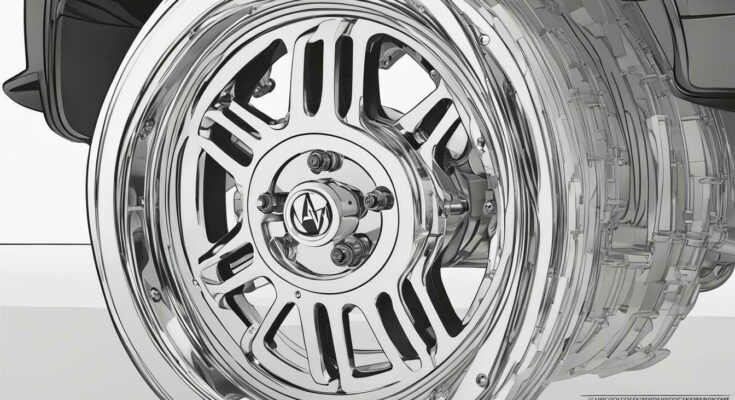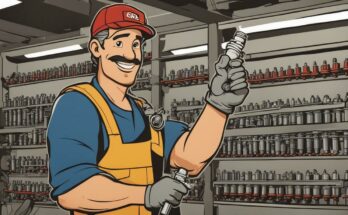If you are a car owner, the term CV joint is likely to have come up at one point or another. But what exactly is a CV joint, and why is it important? In this essential guide, we will provide a comprehensive explanation of what a CV joint is, its function, and how it affects the performance of your vehicle.
A CV joint, also known as a constant velocity joint, is a component that transfers power from the engine to the wheels. It is a critical part of your car’s drivetrain and helps to ensure smooth and controlled movement.
There are two types of CV joints: the inner and outer CV joints. The inner CV joint connects the transmission to the axle, while the outer CV joint connects the axle to the wheel. These joints work together to allow for the transfer of power and facilitate controlled movement.
Key Takeaways:
- A CV joint is a crucial component of your car’s drivetrain.
- It transfers power from the engine to the wheels, allowing for smooth and controlled movement.
- There are two types of CV joints: the inner and outer CV joints.
The Function of a CV Joint
The CV joint, or constant velocity joint, is a key component of a car’s drivetrain. Its primary function is to transfer power from the engine to the wheels while allowing for smooth and controlled movement. Without CV joints, the wheels would not be able to turn and the car would not be able to move forward.
There are two main types of CV joints: the Rzeppa joint and the Thompson coupling. The Rzeppa joint is the most commonly used type and can be found in most cars. It consists of an inner and outer joint connected by a cross-shaped bearing. The Thompson coupling, on the other hand, uses ball bearings to allow for greater range of motion.
The CV joint is designed to withstand a significant amount of stress and torque. However, over time, it can experience wear and tear that can lead to failure. This is why regular maintenance and inspections of the CV joint are important.
The CV Joint in Action
When the car is in motion, the CV joint allows the wheels to turn while maintaining a constant velocity. As the engine turns, the power is transmitted through the transmission and into the CV joint. The CV joint is connected to the wheel hub, which is responsible for turning the wheel.
The CV joint must be able to handle a wide range of motion, including steering and suspension movements. It is also subjected to constant wear and tear from road vibrations and changes in temperature.
To ensure the proper functioning of the CV joint, it is important to inspect it regularly for signs of wear. This includes checking for tears in the rubber boot that protects the joint, as well as listening for clicking or popping noises when turning. If the CV joint is damaged or worn, it will need to be replaced or repaired to ensure safe operation of the vehicle.
Overall, the CV joint plays a crucial role in the performance and safety of a car. By understanding its function and importance, car owners can better maintain their vehicle and address any issues before they become serious problems.
Signs of CV Joint Wear
The CV joint is an essential component of your vehicle’s drivetrain system. Like all mechanical parts, it is subject to wear and tear, which can lead to a variety of problems. Here are some common signs that your CV joint may be experiencing issues:
- Clicking noises while turning: One of the most common signs of a worn-out CV joint is a clicking or popping noise when turning. This could indicate that the joint is low on lubricant, has a damaged boot, or has excessive wear.
- Vibrations while driving: If you feel a vibration in your car’s steering wheel or floorboard while driving, it could be a sign of a damaged CV joint. The vibration may intensify when accelerating or when turning.
- Difficulty turning: A worn-out CV joint can also make your car more difficult to turn. You may notice resistance or stiffness when turning the wheel.
- Loud noises: In some cases, a damaged CV joint can produce loud grinding or thumping sounds. If you hear any unusual noises while driving, have your vehicle inspected by a mechanic immediately.
It’s important to address these symptoms promptly to prevent further damage to your car’s drivetrain and ensure your safety on the road. A damaged CV joint can eventually lead to a complete failure of the joint, which can cause your car to stop moving altogether.
If you’re experiencing any of these symptoms, it’s recommended to have your CV joint inspected as soon as possible. In some cases, a simple repair or replacement of the CV joint may be all that’s needed to restore your car’s performance. Regular maintenance of your car’s drivetrain system can help prevent premature wearing of your vehicle’s CV joint.
CV Joint Replacement and Repair
If you believe your car’s CV joint is experiencing wear and tear, it’s important to get it checked out by a professional mechanic. Delaying repairs could lead to further damage to your vehicle. Here are some possible solutions for fixing your CV joint:
CV Joint Repair
If your CV joint is only showing minor signs of wear, such as cracks or tears, it may be possible to repair it instead of replacing it entirely. A mechanic can assess the damage and determine if a repair is feasible. Some common repairs include replacing the CV joint boot or cleaning and re-packing the joint with grease.
CV Joint Replacement
If the wear and tear on your CV joint is too severe, it will need to be replaced. The replacement process involves removing the old joint and installing a new one. This can be a difficult and time-consuming process, so it’s recommended to have a professional mechanic handle the job.
| CV Joint Replacement Cost | CV Joint Repair Cost |
|---|---|
| On average, expect to pay between $300-$800 for parts and labor. | CV joint repair costs vary, but on average, expect to pay between $150-$350 for parts and labor. |
It’s important to note that the cost of replacement or repair can vary depending on the make and model of your car, as well as the severity of the damage to the CV joint.
Maintenance
Maintaining your CV joint can help prolong its lifespan and prevent future wear and tear. Regularly inspecting the joint for cracks or tears and replacing the CV joint boot as needed can prevent debris and moisture from entering and damaging the joint. Additionally, keeping your car’s suspension system in good condition can prevent unnecessary stress on the CV joint.
By understanding the function of your car’s CV joint and knowing the signs of wear and tear, you can take steps to maintain it and ensure your vehicle performs at its best. If you’re experiencing any of the symptoms mentioned earlier, it’s best to have your car inspected by a professional mechanic.
You may like: Finding Your Perfect Match: What Spark Plugs Do I Need?
Conclusion
Understanding what a CV joint is and its function is crucial for maintaining your car’s performance and safety. By transferring power from the engine to the wheels, the CV joint plays a critical role in ensuring smooth and controlled movement.
Signs of wear and tear, such as clicking noises, vibrations, and difficulty turning, should prompt you to seek timely repairs to prevent further damage to your vehicle. Proper maintenance techniques, including regular inspections and lubrication, can help prolong the lifespan of your CV joint.
Final Thoughts
In conclusion, keeping your CV joint in good condition is essential for the overall health of your car. Whether you are in need of a replacement or repair, it is important to address any issues promptly to avoid costly repairs. Remember, a well-maintained CV joint will not only ensure the longevity of your car but also provide a safer and smoother driving experience.
FAQ
Q: What is a CV joint on a car?
A: A CV joint, also known as a constant velocity joint, is a crucial component of a car’s drivetrain system. It is responsible for transferring power from the engine to the wheels while allowing for smooth and controlled movement.
Q: What is the function of a CV joint?
A: The function of a CV joint is to transfer power from the engine to the wheels while accommodating the up-and-down motion of the suspension. It ensures that the wheels maintain a constant velocity, regardless of any changes in the suspension’s position.
Q: What are the signs of CV joint wear?
A: Common signs of CV joint wear include clicking or popping noises when turning, vibrations while driving, and difficulty turning. These symptoms indicate that the CV joint may be experiencing wear and tear and may require inspection and repairs.
Q: How can I replace or repair a CV joint?
A: If a CV joint is damaged or worn beyond repair, it will need to be replaced. The replacement process involves removing the old CV joint, installing a new one, and ensuring proper alignment. Alternatively, if the CV joint is still in relatively good condition, repairs may be possible. This could involve regreasing the joint, replacing the boot, or addressing any other specific issues. It is recommended to consult a professional mechanic for CV joint replacement or repair.



